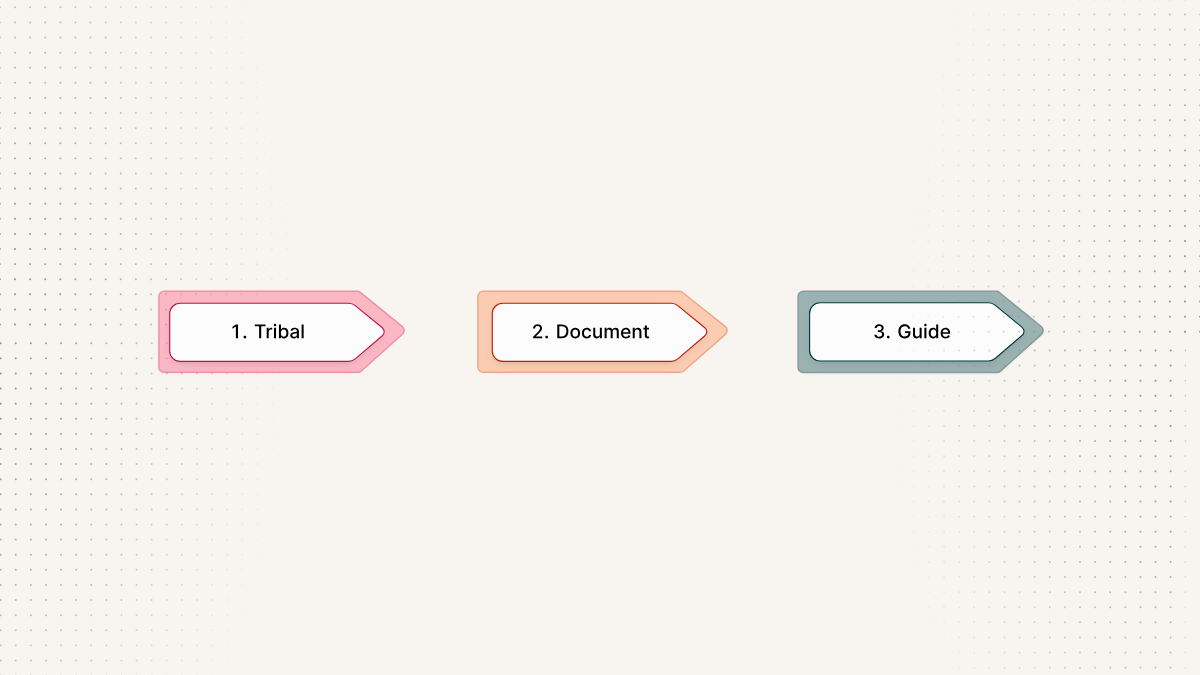The Knowledge Ops Maturity Model: How Effective Are Your Knowledge Operations?
How well does your organization manage and transfer knowledge?
Is your knowledge operationalized, or is there room for improvement?
Often, companies don't know the answer to these questions. Why? It's difficult to evaluate how well you are doing when you don't have anything but a feeling to measure against, so we created the Knowledge Ops Maturity Model.
ScreenSteps — the world's first Knowledge Ops Platform — developed the Knowledge Ops Maturity Model to help companies understand how efficiently their Knowledge Operations function, meaning how efficiently they manage and transfer company knowledge.
This article explains each stage of the Knowledge Ops Maturity Model. Use these definitions to help you determine which stage you’re in. It will be your benchmark for the future as you set goals for where you want your Knowledge Ops to improve.
What are Knowledge Operations (Knowledge Ops)?
Before diving into the Knowledge Ops Maturity Model, it is important to understand what Knowledge Operations are.
Knowledge Operations (Knowledge Ops) are the systems an organization has in place to enable employees to confidently and independently perform their jobs correctly and efficiently.
Knowledge Ops are the process of aligning your team by organizing data and information for everyone to access and reference on the job. It refers collectively to both:
- Employee training (i.e. onboarding and training strategy) AND
- Employee support (i.e. digital guides and resources)
While it shares aspects of knowledge management, it is different in purpose. The intention of knowledge management is simply to capture and organize knowledge.
Knowledge Operations, on the other hand, emphasizes user experience. This means that data and information isn't just collected and stored, but it is captured in a way that an end-user can use it without additional help.
An organization that has ineffective Knowledge Operations will have employees who are constantly seeking help from supervisors.
Those with effective Knowledge Ops will have employees who can work independently and adjust to changes in policies and procedures without extensive retraining or help from supervisors.
What does the Knowledge Ops Maturity Model help organizations do?
The Knowledge Ops Maturity Model is a scale to help organizations understand:
- How they are using knowledge in their organization
- What steps they can take to use knowledge more effectively
ScreenSteps developed the chart to help leaders recognize the state of their Knowledge Operations and knowledge management.
Your company can use the model to understand how you are transferring and using knowledge. Then the model helps you set goals to improve efficiencies as you move up through the various stages of the model.
Watch this 3.5-minute video for a brief overview of the three stages of the Knowledge Ops Maturity Model.
Note: Originally, the Knowledge Ops Maturity Model included five stages. We have since simplified the model to three stages.
The Knowledge Ops Maturity Model
There are three stages in the Knowledge Ops Maturity Model, with Stage 1 being the least effective and Stage 3 being the most effective.
The same organization may have teams and departments that are operating at different stages.
The stages are:
Stage 1: Tribal
At the Tribal Stage, organizations rely completely on tribal knowledge. Tribal knowledge is where information is passed by word of mouth.
For example, co-workers ask each other how to handle different situations or they rely on supervisors for answers. Employees use email, messenger, and tapping a neighbor on the shoulder to get the answers they don't remember.
Often, you see desks (or desktops) with written reminders on sticky notes.
New employees are trained by listening to lectures, shadowing, and nesting. Training is centered around memorizing the clicks and steps for every policy and procedure.
The results? Supervisors spend most of their time answering questions and fixing mistakes. Employees are dependent on supervisors and do not feel confident working on their own. There are frequent mistakes, and everyone is stressed.
Key indicators your organization is in Stage 1
How do you know if your organization is in the Tribal Stage? There are a few key indicators.
- You have no documentation
- You have no centralized knowledge hub
- Employee onboarding takes a long time
- Training relies on memorization
- Supervisors have no time to work on projects
- Employees frequently make mistakes
- Employees use sticky notes as reminders
- Everyone is stressed and overwhelmed
Stage 2: Document
In the Document Stage, you've moved into a knowledge management strategy.
Organizations start to document their systems, policies, and procedures. But, nobody uses the documentation on a regular basis.
Employees still largely rely on supervisors to for step-by-step support because documentation has not been designed for the end-user experience.
Documentation in this stage often resides in Word, PDF, PowerPoint, or Excel files that are hard to search. Or it may reside in an online knowledge base — like SharePoint — but it is difficult to navigate and find answers.
The point is that even when employees find them, they encounter massive walls of text that are difficult to understand quickly. The documentation is unusable.
For onboarding and training, you may a learning management system (LMS) for self-paced learning along with in-person or virtual training sessions. However, new hires still leave training without the skills to do their jobs.
The results are the same at the Tribal Stage. Your customer experience is inconsistent, employees are dependent on supervisors, and everyone is stressed.
Key indicators your organization is in Stage 2
Is your company in the Document Stage? Here are a few common signs that you're operating in Stage 2 of the Knowledge Ops Maturity Model:
- You have some — or even a lot — of documentation
- Your documentation (i.e. SOPs, job aids, etc.) is rarely used
- Your documentation is outdated and contains inaccurate information
- Employees frequently make mistakes
- Employees don't use your knowledge management system
- Supervisors have no time to work on projects
- New hires leave training without the skills to do their jobs
Stage 3: Guide
The Guide Stage takes things a step further. Instead of just answering questions, organizations in the Guide Stage design knowledge experiences that guide employees through every task and interaction.
Employees don't just use documentation when they get stuck. They follow digital guides, decision trees, and checklists that help them:
- Complete tasks, answer questions, and solve problems independently
- Work confidently
- Achieve proficiency quickly
- Adjust to changes immediately
Organizations operating at the Guide Stage are more agile and effective. That's because they are using a Knowledge Operations Strategy.
They use a Knowledge Ops Platform to empower employees with findable, followable, and scannable digital guides that they can access in seconds. They have a system for maintaining knowledge so digital guides are always up to date.
The result is faster training, increased consistency in service, increased supervisor bandwidth, and confident and independent employees.
Key indicators your organization is in Stage 3
An organization operating in the Guide Stage, looks like this:
- Employees can handle simple or complex tasks without supervisor assistance
- Supervisors have time to work on projects
- Employees rarely make mistakes
- Onboarding new hires takes 30 days or less
- New hires leave training ready to work independently
- Employees trust and rely on your Knowledge Ops Platform
- Cross-training is easy, taking as little as a day
What happens when you move up the Maturity Model?
Organizations that move up the Maturity Model are more agile and can handle changes big and small. That includes digital transformations, core conversions, and other change management projects.
When you move to the Guide Stage, you don't have to worry about knowledge walking out the door when employees quit or retire. Every employee becomes an expert.
As you advance from tribal knowledge to guided knowledge (aka the Guide Stage), you inspire confidence, encourage independence, and decrease the mental load on your employees. This makes it easier for your organization to scale up or down.
Here are some examples of outcomes organizations have achieved:
- Decreased average task time by 50%
- Decreased new hire training time by 50%
- Decreased Time to Proficiency for complex tasks from 24 weeks to 4 weeks
- Decreased cross-training times from 30 days down to 1
You can view real customer results and stories here about adopting a Knowledge Operations Strategy and moving up the Knowledge Ops Maturity Model.
Where are you at on the Knowledge Ops Maturity Model?
Use the model to assess where your organization is at and where you would like to be.
At ScreenSteps, we’ve helped companies from multiple industries improve their Knowledge Operations. With a ScreenSteps Knowledge Ops Platform, organizations that have started in the Tribal Stage advance to the Guide Stage.
Don’t know where your company fits? Or want to improve your company’s Knowledge Ops?
Talk to a ScreenSteps expert. They can help you identify where your company fits on the Knowledge Ops Maturity Model and create a plan to advance to the Guide Stage with ScreenSteps.




